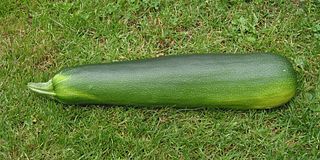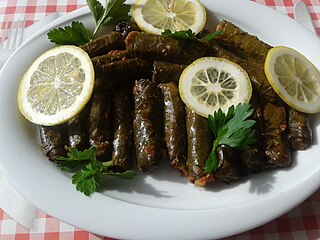
Turkish cuisine is the cuisine of Turkey and the Turkish diaspora. It is largely the heritage of Ottoman cuisine, which can be described as a fusion and refinement of Mediterranean, Balkan, Middle Eastern, Central Asian and Eastern European cuisines. Turkish cuisine has in turn influenced those and other neighbouring cuisines, including those of Southeast Europe (Balkans), Central Europe, and Western Europe. The Ottomans fused various culinary traditions of their realm taking influences from and influencing Mesopotamian cuisine, Greek cuisine, Levantine cuisine, Egyptian cuisine, Balkan cuisine, along with traditional Turkic elements from Central Asia, creating a vast array of specialities. Turkish cuisine also includes dishes invented in the Ottoman palace kitchen.

The zucchini, courgette or baby marrow is a summer squash, a vining herbaceous plant whose fruit are harvested when their immature seeds and epicarp (rind) are still soft and edible. It is closely related, but not identical, to the marrow; its fruit may be called marrow when mature.

Moussaka is an eggplant- or potato-based dish, often including ground meat, which is common in the Balkans and the Middle East, with many local and regional variations.

Dolma is a family of stuffed dishes associated with Ottoman cuisine, and common in modern national cuisines of regions and countries that once were part of the Ottoman Empire. Some types of dolma are made with whole vegetables, fruit, offal or seafood, while others are made by wrapping grape, cabbage, or other leaves around the filling. Wrapped dolma are known as sarma. They can be served warm or at room temperature.

A marrow is a fruit used as a vegetable, the mature fruit of certain Cucurbita pepo cultivars. The immature fruit of the same or similar cultivars is called courgette or zucchini. Like courgettes, marrows are oblong, green squash, but marrows have a firm rind and a neutral flavour, making them useful as edible casings for mincemeat and other stuffings. They can be stored for several weeks after harvest, to be processed for food when required. They are a vegetable used in Great Britain and areas with significant British influence, though their popularity is waning in favor of immature summer squash like courgette.

Bulgarian cuisine is part of the cuisine of Southeast Europe, sharing characteristics with other Balkan cuisines. Bulgarian cooking traditions are diverse because of geographical factors such as climatic conditions suitable for a variety of vegetables, herbs, and fruit. Aside from the vast variety of local Bulgarian dishes, Bulgarian cuisine shares a number of dishes with Persian, Turkish, and Greek cuisine.

Kibbeh is a family of dishes based on spiced ground meat, onions, and grain, popular in Middle Eastern cuisine.

Iraqi cuisine or Mesopotamian cuisine is a Middle Eastern cuisine that has its origins from Sumerians, Akkadians, Babylonians, Assyrians and the other groups of the region.

Cypriot cuisine is the cuisine of the island of Cyprus; shared by both Greek Cypriots and Turkish Cypriots.

Sarma, commonly marketed in the English-speaking world as stuffed grape leaves, stuffed vine leaves, or stuffed cabbage leaves, is a food in Southeastern European and Ottoman cuisine made of vegetable leaves—such as cabbage, patience dock, collard, grapevine, kale or chard leaves—rolled around a filling of grains, minced meat, or both. Sarma is part of the broader category of stuffed dishes known as dolma.

Ottoman cuisine is the cuisine of the Ottoman Empire and its continuation in the cuisines of Turkey, the Balkans, Caucasus, Middle East and Northern Africa.

Stuffed peppers is a dish common in many cuisines. It consists of hollowed or halved peppers filled with any of a variety of fillings, often including meat, vegetables, cheese, rice, or sauce. The dish is usually assembled by filling the cavities of the peppers and then cooking.

Neapolitan cuisine has ancient historical roots that date back to the Greco-Roman period, which was enriched over the centuries by the influence of the different cultures that controlled Naples and its kingdoms, such as that of Aragon and France.

Stuffed squash, courgette, marrow, mahshi, or zucchini is a dish common in the region of the former Ottoman Empire from the Balkans to the Levant and Egypt, a kind of dolma. It consists of various kinds of squash or zucchini stuffed with rice and sometimes meat and cooked on the stovetop or in the oven. The meat version is served hot, as a main course. The meatless version is considered an "olive-oil dish" and is often eaten at room temperature or warm.

Kamokamo is a variety of Cucurbita pepo, grown as a summer or winter squash in New Zealand. Commonly used in Māori cuisine, the Kamokamo is a heavily ribbed oblate or prolate shaped stocky fruit with speckled green skin, ripening to an orange colour. It is thought to have been introduced to New Zealand during European settlement around the late 19th century and was readily adopted by Māori, displacing the calabash as a food source. Its name originates from the Māori language.

Aehobak, also called Korean zucchini or Korean courgette, is an edible, green to yellow-green summer squash. Although nearly all summer squashes are varieties of Cucurbita pepo, aehobak belongs to the species Cucurbita moschata. Commonly used in Korean cuisine, an aehobak has the shape of zucchini, but with thinner, smoother skin, and more delicate flesh. It is usually sold in shrink-wrapped plastic.

Menorcan cuisine refers to the typical food and drink of Menorca.
























